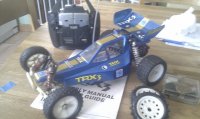TOPIC:
Re: Acoms 2-channel stick radio evolution 11 years 11 months ago #9481
|
The receiver that originally came with the Mk3/Techniplus (The waterproof one with integral servo leads rather than just sockets) had built-in BEC, so could be plugged directly into the main run battery if you wanted to do away with a seperate receiver pack. To be sure, look for the "BEC" logo on the receiver label.
Another check is to check the receiver supply output from the TEU104 (Measure volts across red/black wires in red plug) - it'll be safe to use with any receiver if it doesn't exceed about 6V (It should be a stable 5V). Another trick to get rid of the receiver battery & use the main battery to power the receiver, is to use Tamiya's special voltage dropping receiver switch (As fitted to Hotshot etc) OR a cheaper equivalent is the LM7812 regulator chip (Don't be scared, it's only 3 pins & no other components to use)
Custom F2
...
Hilux crossmember drawing
...
F2 axle drawing
...
Quattro radio lid
...
Holiday Buggy motor bracket drawing
...
Quattro resto
...
HitnMiss engine
...
Wild Willy resto
...
Mardave Cobra resto
...
Thunder Dragon resto
...
Grasshopper resto
...
XR311 resto
...
Modded XR311
...
Carbon 25th scratch build
|
|
|
Please Log in to join the conversation. |
Re: Acoms 2-channel stick radio evolution 11 years 11 months ago #9485
|
Just looked again and realized that it's not an ARC 227 but in fact an ARC 275. I know that I can run the AS-7 servo and I'm currently using the Techniplus acoms AP-275 MKIII TX. Problem is that the ARC does not have BEC built in and I do not want to fry the ESC. I'll check the voltages tomorrow to make sure that they are not running higher than 5V. I'll buy a battery box if I have to. The Blackfoot was designed for that.
Also, is there going to be a problem running these older AM radios. I don't want to upgrade to 2.4 cause quite frankly I love older technology and I'm also too cheap to buy a new 2.4 Ghz radio. |
|
|
Please Log in to join the conversation. |
Re: Acoms 2-channel stick radio evolution 11 years 11 months ago #9486
|
I've never heard of an AP-275 mk.III TX or an ARC-275 RX, but going by the Acoms number system for that period (Nnn - N = # of channels, nn = frquency), it simply should be the mk.III TX & ARC RX in 75mhz for surface use in the US & Canada ... I'd love some pics to add to the OP
The ARC 227 RX's _didn't_ have BEC, or at least mine didn't, and the only other example on this site that I know of (owned by agemax) doesn't, maybe later ones do (or multichannel jobs do - is there an ARC-427 or ARC-440?), but I'm extremely skeptical - I know the ARD did, but AFAIK that was a prototype & was never released, the first RX to have BEC was the ARE. If you haven't already bought an ESC, the Mtroniks range don't have the ESC frazzling problems than Tamiya ESCs do. There's no problem with _you_ using that TX/RX combo, the only question is if someone else will ... the 75mhz band now has 30 channels, but I really don't know how many were specified when that radio was built, if it 10 or something, then the frequency output by your TX might not be as tightly controlled as a later set & might interfere with a couple of channels either side - newer radios are also less powerful, so might drown out the signal from the other hypothetical drivers TX. At a Tamiyaclub bash a while back, I remember someone using an old 500mw 27mhz TX on a "solid" colour, while some poor sucker (me) was attempting to drive on a "split" frequency with a 100mw TX ... I say "attempting" as the more powerful TX drove both his car & mine |
|
Please Log in to join the conversation. |
Re: Acoms 2-channel stick radio evolution 11 years 10 months ago #9512
|
Yes, the ARC275 IS 75MHz, don't know if it's AM or FM, but NO it definately hasn't got BEC - had one a few months back to put a new aerial wire on it.
Both of my Mk3/Techniplus RXs were definately BEC, but haven't got them any more to double-check their model numbers. If in doubt, just use the voltage dropping RX switch that Tamiya do, just to be safe, it won't hurt anything. Although I haven't tried it, the ESC will be safe & should still work if you only connect it to the RX by the black (0V/reference) & the white (Signal) wires (Don't connect the red) of the 3-pin lead - the ESC electronics are usually powered by the main run battery, so it shouldn't need a seperate power supply. It'll need the white to tell it what to do & when, & the black's needed as a 0V reference point. IF the ESC has an extra lead, (Thin wires, red/black) with a 2-pin plug, this should be a 5V output to power the RX, to use instead of a seperate radio battery. To be sure, test across the red & black leads of this connector to ensure it only puts out around 5-6V, even when the main battery is fully charged. Some Tamiya MSCs also have this 2-pin plug, but it's connected directly to the run battery with NO voltage dropping & shouldn't be used unless you're SURE you have a BEC RX or a voltage-dropping type RX switch
Custom F2
...
Hilux crossmember drawing
...
F2 axle drawing
...
Quattro radio lid
...
Holiday Buggy motor bracket drawing
...
Quattro resto
...
HitnMiss engine
...
Wild Willy resto
...
Mardave Cobra resto
...
Thunder Dragon resto
...
Grasshopper resto
...
XR311 resto
...
Modded XR311
...
Carbon 25th scratch build
|
|
|
Please Log in to join the conversation. |
Re: Acoms 2-channel stick radio evolution 11 years 8 months ago #11632
|
I'm trying to get a couple of Tamiya models going as cheaply as possible and I'm not too worried about originality. I've got an assortment of servos and receivers that are confirmed working using my son's AP-227 MKII to test, but no working transmitters. I do have an AP-227 MK I where the battery terminals have dissolved and an AP-227 MK II that doesn't seem to work at all (but may warrant further investigation).
I have seen several transmitters listed on eBay as new, with various part numbers (suspect they are new old stock). I am assuming that so long as I go for a 27MHz version, they should be compatible with my old receivers. The one that is tempting me at the moment is listed as an AT-201 at |
|
Please Log in to join the conversation. |
Re: Acoms 2-channel stick radio evolution 11 years 8 months ago #11635
|
I'm sure you're right about AT-201 being Acoms' part number for that transmitter _without_ an antenna, I've seen it a few times.
The antenna from your mk.1 and mk.2 sets are _not_ compatible with that TX though - you'll need to fork out another 5.50 GBP to get the correct one. I wouldn't want to guarantee that TX would work with any combination of RX & servos, but I don't think I've ever had radio compatibility issues with acoms 27mhz gear. |
|
Please Log in to join the conversation. |
Re: Acoms 2-channel stick radio evolution 11 years 8 months ago #11637
|
I have been (& still do) use 27MHz AM radio, & in all my years of messing about using mis-matched Tx-Rx setups, I can safely say the only time they haven't worked together has been when either the Rx or Tx has been a generic "toy" item (eg something from Argos, Tandy etc). Even the more upmarket versions of the Nikko gear (With changeable crystals) will work, although with reduced range. Only thing to watch for is the neutral position of the servos is likely to be different (But this can be changed by removing/repositioning the horns).
Different manufacturers usually work ok together too, the more well-known the better your chances. I can even tell you that the 4 channel Acoms 27am transmitters will talk to 2 channel 27am receivers, but only driving 2 of 4 channels. Same goes for Traxxas TQ3 3-channel 27am transmitters with Acoms/Futaba/Sanwa 2 or 4 channel receivers. (Incidentally, these can be made to output with 4 channels, as can the AP201 Techniplus Alpha). eg, my most up-to-date transmitter I currently have is an AP202, & it'll happily drive my oldest M-series Futaba receiver. Having rattled on though, I've never heard of an AT-201. I'd guess that as long as it's 27MHz AM, & has changeable crystals, there's a 95% chance it'll be ok with a well-known brand 27MHz AM receiver, better still if it's from the same manufacturer (ie Acoms). Aerial wise, as you've probably already discovered, these normally screw in to the transmitter body. MOST have either a male or female thread of just one size. However, it is possible (If you're ok doing this sort of thing, have the parts & tools) to change the threaded bush for a different type, or even solder the aerial base to the tab on the circuit board inside the transmitter case, as long as the aerial physically fits into the transmitter. Again, I've only known Acoms to use 2 different sizes, the larger being for the 4-channel &/or older sets. Too small's ok, just heatshrink or tape-wrap locally to where it passes into the case, to bulk the diameter out, so it doesn't bang about (As this is likely to break the connection on the board). As for non-functional 27am transmitters, there's not really much that can go wrong with them, & ALL that I've bought as non-working have never been due to the electronics - USUALLY, any problem will be with dirty/corroded battery terminals, the main power switch, or where the battery terminals are connected to the internal board - if the power meter doesn't work, look here first. If the power meter works, but it won't talk to the receiver, obviously check the receiver, its crystals & power supply are ok (Try a different tranny) first, & once you're happy it's definately the tranny that's unhappy, look at the aerial connection to the board - dirty/corroded screw-in connection, threaded tab come away from the board, duff crystal, loose crystal pins, crystal socket come away from the board. In summary, electronics are fairly reliable, especially when they're non-moving & enclosed/protected. Problems are usually related to what I call "Outside input" ie something the user has done eg twatted the aerial, dropped it, left batteries in, used/stored in the damp, aggressive use etc. & these are usually all easy fixes. I usually get my transmitters from the spares-repair section on Ebay, preferrably as multiple-item job-lots. I won't pay more than 5 quid inc p+p, even for a perfect working order one. STAY AWAY from transmitters with missing/broken aerials though, as telescopic aerials often cost more on their own than a complete transmitter!
Custom F2
...
Hilux crossmember drawing
...
F2 axle drawing
...
Quattro radio lid
...
Holiday Buggy motor bracket drawing
...
Quattro resto
...
HitnMiss engine
...
Wild Willy resto
...
Mardave Cobra resto
...
Thunder Dragon resto
...
Grasshopper resto
...
XR311 resto
...
Modded XR311
...
Carbon 25th scratch build
|
|
|
Please Log in to join the conversation. |
Re: Acoms 2-channel stick radio evolution 11 years 8 months ago #11640
|
Thanks Eddrick, that's useful information. As I said, my son has a tamiya Frog with a AP-227 MkII Tx, so I borrowed that to quickly test some of my Rx's and servos and found I have at least two working sets.
The issue with my AP-227 MKI is corroded/dissolved battery terminals (left the batteries in Not sure what the issue is the AP-227 MKII as I have only looked at it briefly. You are probably right - it will just be corrosion somewhere from being stored in a damp shed for 20+ years. To be honest I'm just being lazy as I thought I would just buy a new Tx off ebay for less than a tenner, bung in the aerial from my old tranny and Bob's your Uncle. To be fair, the eBay seller did tell me that my old aerial would not fit as it has a female thread. I thought I could use an M3 stud to join the two, but I did not realise they were different diameters. This means the old aerial probably won't fit through the hold in the Tx case. I should pull my finger out and try to repair the old trannys. I have no excuse as I am an electronics engineer by training (although not done any theory for a long time). |
|
Please Log in to join the conversation.
Last edit: by Martin Bell.
|
Re: Acoms 2-channel stick radio evolution 11 years 8 months ago #11643
|
Sorry to have made the info difficult to read though - as anybody on here will tell you, I do tend to bang on a bit....
Yes, can't see any problem hardwiring a NiCd pack into the Mk1, & being an electronics engineer you'll probably appreciate it's worth putting in a 3.5mm charging jack whilst it's in bits (Battery +ve to centre poles on the power switch, feed to PCB on the poles in the ON position, connection to charging jack on the poles in the OFF position, all -ve wires commoned not through switch). Another option - I've recently seen battery boxes for sale on Ebay with 1x4 battery orientation, they might also do a 1x6, & being made of ABS, it might be an easy job to integrate one of these into the battery compartment of the transmitter with a bit of cutting & gluing, IF you still wanted the possibility of using dry cells... I'll lay money the Mk2 will be a skanky power switch (Assuming battery terminals are clean) - squirt WD40 into it & work the switch lots of times until the meter responds. If the car/receiver switch has lived in the same place, it'll be worth doing the same to that switch too - I've seen them get dirt-related non-functional after just getting wet & not used for a week. From experience, most RC car electronics seem to be fairly hardy. Most of the time, if you've been out playing in the wet & something stops working, turn it off, have the various items apart & dry them out & 9/10 it'll be ok again. The only thing electronics-related I've ever really seen problems with is fried FETs in electronic speed controls - most of the time it's been from shorts in motor wiring that's caused it, some have been from wrong power polarity (Most have built-in protection against this though) & there's been a lot with underrated FETS, mostly M-Tronics (& if Jonny's reading this, he'll suddenly understand my hatred for them!). "Dead" receivers are normally the aerial wire broken internally, close to the case, or servo connections broken off the PCB (Hairline solder cracks local to the servo pins), or in the case of BEC receivers, it's usually the 5v regulator chip (Usually a micro 7805) & if this is the problem, it's worth investigating the servos & their wiring. High-torque servos can also make them do this.
Custom F2
...
Hilux crossmember drawing
...
F2 axle drawing
...
Quattro radio lid
...
Holiday Buggy motor bracket drawing
...
Quattro resto
...
HitnMiss engine
...
Wild Willy resto
...
Mardave Cobra resto
...
Thunder Dragon resto
...
Grasshopper resto
...
XR311 resto
...
Modded XR311
...
Carbon 25th scratch build
|
|
|
Please Log in to join the conversation. |
Re: Acoms 2-channel stick radio evolution 11 years 8 months ago #11645
|
oh, just to add re: Tx battery pack - you'll notice the AP227 mk1 & 2 only take 6x AA cells, whereas most modern sets take 8x. They're designed to run around 9v - rechargeables weren't that common back then so 6x 1.5v dry cells gave you you 9v. Nowadays, most are designed to run 9-12, (9.6v nominal) to cater for using dry or rechargeable cells. If you're gonna put in a rechargeable pack in an older tranny, perhaps a 7-cell pack might be better? (7x 1.2v normal = 8.4v, 7x "just charged" 1.4v = 9.8v. Verses 7.2v-8.4v of a 6-cell AA pack). You may or may not have already noticed that when using these older transmitters with rechargeable batteries, the power meter never shows better than "just about good", which can affect range & cleanliness of signal
Custom F2
...
Hilux crossmember drawing
...
F2 axle drawing
...
Quattro radio lid
...
Holiday Buggy motor bracket drawing
...
Quattro resto
...
HitnMiss engine
...
Wild Willy resto
...
Mardave Cobra resto
...
Thunder Dragon resto
...
Grasshopper resto
...
XR311 resto
...
Modded XR311
...
Carbon 25th scratch build
|
|
|
Please Log in to join the conversation. |
Time to create page: 0.242 seconds




